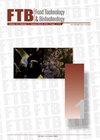Total Antioxidant Potential, Total Phenolic Profile and Cytotoxic Activity Against Brain Cancer: Melocan and Galdirik
IF 2.5
4区 农林科学
Q3 BIOTECHNOLOGY & APPLIED MICROBIOLOGY
引用次数: 0
Abstract
Research background. Brain cancer is known to be one of the most difficult types of cancer to be cure. It has serious impact on the lives of diagnosed people due to the insufficient treatment options and their side effects. Thus, the search for novel alternative treatments is ongoing. Melocan (Smilax excelsa L.) and Galdirik (Trachystemon orientalis) are significant contributors to both traditional culinary culture and traditional medicine around Black Sea; however, the evidence regarding their antioxidative and cytotoxic effects remains fairly limited. Experimental approach. This study aimed to determine the antioxidant and cytotoxic activity of Smilax excelsa and Trachystemon orientalis, on the C6 glioblastoma cell line. Smilax excelsa and Trachystemon orientalis plants were dried and extracted; then, the total phenolic content (TPC) and their phenolic profiles were studied. In addition, their Total Antioxidant Status (TAS) and Total Oxidant Status (TOS) were determined by using an assay kit. We also analyzed the total antioxidant activity (TAA) using the DPPH radical scavenging assay and the cytotoxic impact on the glioma cells via the 3-(4,5-dimethylthiazol-2 yl)-2,5-diphenyltetrazolium (MTT) assay. Results and conclusions. According to the results, the water extracts of both Smilax excelsa (1158.17 mg gallic acid eq./100 g DM) and Trachystemon orientalis (262 mg gallic acid eq./0 g DM) had higher TPC than the ethanol extracts. TAA were measured as 192.86 mg and 131.92 Trolox eq./100 g DM for the Smilax excels and Trachystemon orientalis, respectively. The MTT assay revealed that Trachystemon orientalis had a greater cytotoxic effect. In conclusion, the findings of the current study are promising. Novelty and scientific contribution. This is the first study that aimed to evaluate the potential cytotoxic activity of two local Turkish plants, Smilax excelsa and Trachystemon orientalis, against C6 glioblastoma cells and the findings ensure that both plants may be used in the future as good therapeutic agents for treating cancer.总抗氧化潜能、总酚类概况和对脑癌的细胞毒活性:Melocan 和 Galdirik
研究背景。众所周知,脑癌是最难治愈的癌症类型之一。由于治疗方案不足及其副作用,它严重影响了确诊患者的生活。因此,人们一直在寻找新的替代治疗方法。Melocan (Smilax excelsa L.)和 Galdirik (Trachystemon orientalis)是黑海地区传统烹饪文化和传统医学的重要组成部分;然而,有关其抗氧化和细胞毒性作用的证据仍然相当有限。实验方法。本研究旨在确定菝葜和东方桔梗对 C6 胶质母细胞瘤细胞系的抗氧化和细胞毒性活性。研究人员首先对Smilax excelsa和Trachystemon orientalis植物进行干燥和提取,然后研究了它们的总酚含量(TPC)和酚谱。此外,还使用检测试剂盒测定了它们的总抗氧化状态(TAS)和总氧化状态(TOS)。我们还利用 DPPH 自由基清除试验分析了总抗氧化活性(TAA),并通过 3-(4,5-二甲基噻唑-2 yl)-2,5-二苯基四唑(MTT)试验分析了对胶质瘤细胞的细胞毒性影响。 结果和结论。结果表明,Smilax excelsa 水提取物(1158.17 毫克没食子酸当量/100 克 DM)和 Trachystemon orientalis 水提取物(262 毫克没食子酸当量/0 克 DM)的 TPC 均高于乙醇提取物。经测定,Smilax excels 和 Trachystemon orientalis 的 TAA 分别为 192.86 mg 和 131.92 Trolox eq./100 g DM。MTT 试验表明,东方桔梗的细胞毒性作用更大。总之,目前的研究结果很有希望。新颖性和科学贡献。这是第一项旨在评估两种土耳其本地植物(Smilax excelsa 和 Trachystemon orientalis)对 C6 胶质母细胞瘤细胞的潜在细胞毒性活性的研究。
本文章由计算机程序翻译,如有差异,请以英文原文为准。
求助全文
约1分钟内获得全文
求助全文
来源期刊

Food Technology and Biotechnology
工程技术-生物工程与应用微生物
CiteScore
3.70
自引率
0.00%
发文量
33
审稿时长
12 months
期刊介绍:
Food Technology and Biotechnology (FTB) is a diamond open access, peer-reviewed international quarterly scientific journal that publishes papers covering a wide range of topics, including molecular biology, genetic engineering, biochemistry, microbiology, biochemical engineering and biotechnological processing, food science, analysis of food ingredients and final products, food processing and technology, oenology and waste treatment.
The Journal is published by the University of Zagreb, Faculty of Food Technology and Biotechnology, Croatia. It is an official journal of Croatian Society of Biotechnology and Slovenian Microbiological Society, financed by the Croatian Ministry of Science and Education, and supported by the Croatian Academy of Sciences and Arts.
 求助内容:
求助内容: 应助结果提醒方式:
应助结果提醒方式:


